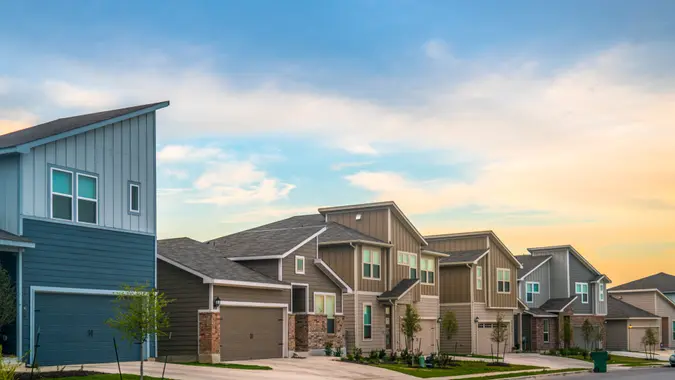How Much House the Middle Class Could Afford in the 1980s Compared to Now

Commitment to Our Readers
GOBankingRates' editorial team is committed to bringing you unbiased reviews and information. We use data-driven methodologies to evaluate financial products and services - our reviews and ratings are not influenced by advertisers. You can read more about our editorial guidelines and our products and services review methodology.

20 Years
Helping You Live Richer

Reviewed
by Experts

Trusted by
Millions of Readers
According to data from the National Association of Realtors, the median price for an existing home was $387,600 as of November 2023, up 4% from a year ago.
If you’re an aspiring homeowner in states with a high cost of living, expect to shell out even more. Recent Zillow data shows the typical value of homes in New York and California currently sits at $729,936 and $746,055, respectively.
With home prices soaring and some even surpassing the seven-figure mark, we can’t help but wonder, is homeownership becoming more unattainable than ever? Did our parent’s generation have it better than us?
The 1980s Compared To Now: Home Price Appreciation and Wage Growth
Before taking a look at how much house the middle class could afford in the 80s compared to now, we must first consider how fast home prices have appreciated compared to wage growth.
According to St Louis Fed data, home prices in California appreciated by a compound annual growth rate (CAGR) of 5.3% over the last 40 years. On the other hand, California’s minimum wage has only increased by a CAGR of 4% over the past 40 years,
So, how much of an impact does this difference in housing prices and wage growth have on housing affordability?
Joe Salerno, co-founder and chief investment officer at Yardsworth — a company offering debt-free alternatives to home equity loans — provided this example to illustrate:
“Let’s assume someone could have afforded a $127k home in California in 1984 — today that home is worth $1 million (5.3% CAGR for 40 years), but their 4% wage growth would imply they could only afford a home worth $610k today!
“At first blush, it appears that today’s home prices would need to fall 39% ($390k in this example) to match 1984’s affordability levels based on wage growth.”
However, Salerno emphasized that we must also consider mortgage rates to compare housing affordability in the 80s and now. In January 1984, mortgage rates were 13.3%, much higher than today’s.
“So, what’s more expensive, today’s million-dollar home at today’s 6.6% interest rate, or the wage-adjusted $610k home at 1984’s 13.3% mortgage rate?” asked Salerno.
“The million-dollar house today would cost $6,018 each month after property taxes and P&I on the mortgage at a 6.6% mortgage, and the wage-adjusted $610k house would cost $6,158 per month at 1984’s 13.3% mortgage. Both assume 20% down.”
In other words, housing is actually more affordable in California today than it was in the 1980s on a monthly mortgage payment basis — when adjusted for wages and mortgage rates.
With many other states in the country following a similar trend in housing price appreciation and wage growth, it’s safe to assume that the middle class could afford more houses in many U.S. states now compared to the 80s.
Why Are Americans Today Struggling To Afford Housing?
If today’s mortgage rates are much lower than the exorbitant rates 40 years ago, why are so many first-time home buyers having difficulty affording a house?
Building on his earlier example, Salerno said, “Assuming a 20% down payment was made on the 1984 house and today’s house, a homebuyer needs to come up with a 64% bigger down payment today to account for how much faster home prices have grown in the last 40 years vs wages — which is a monumental undertaking.”
So, despite the fact that the actual monthly payment is lower on a real wage-adjusted monthly basis than it was in 1984, saving that down payment is quite unattainable for the average middle-class American without reaching out for assistance from loved ones.
Other Factors That Have Made Housing More Expensive
Besides home prices growing faster than the average wages of middle-class Americans, the following factors have also contributed to the housing crisis younger generations are experiencing.
HOA Dues
“In the 1980s, Homeowners Association (HOA) dues were minimal, reflecting the simplicity and straightforward nature of neighborhood living,” said Ron Wysocarski, broker and CEO of Wyse Home Team Realty. “Properties boasted basic amenities, with residents assuming the maintenance responsibility.”
Fast forward to today, Wysocarski said he’s noticed a significant paradigm shift in the real estate market. “Residents now invest in a lifestyle, fostering a growing trend of shared amenities and communal living,” he explained.
And with more and more apartments and housing communities featuring modern amenities, it has resulted in a noticeable surge in HOA dues.
Property Taxes
Like HOA dues, property taxes have transformed since the 1980s.
Back then, they were often modest and stable, designed to incentivize homeownership. Today, the increasing property taxes have significantly affected the overall housing affordability for the middle class.
As the co-owner of ASAP Properties based in Cincinnati, Ohio, specializing in providing homeowners with fast and easy home-selling solutions, Shannon Feick, explained it, “The rise in property taxes, coupled up with the current market trends of high demand and low supply, has made it more challenging for today’s middle class to afford similar homes that were easily within reach in the 80s.”
Ways To Make Homeownership Affordable for You
- Consider First-Time Homebuyer Programs. Check out government-backed programs designed to assist first-time homebuyers, like FHA loans, USDA loans, and Fannie Mae Standard 97 Loans. These programs typically have much lower down payment requirements and reduced interest rates.
- Boost Your Credit Score. A higher credit score can qualify you for better mortgage rates. Pay bills on time, reduce outstanding debts and dispute any errors in your credit report to boost your score.
- Consider Fixer-Uppers. Buying a fixer-upper house is often cheaper than a move-in ready home. While you may have to invest some time and money to renovate and upgrade the place, it could be worth the investment and savings if you budget correctly.
 Written by
Written by  Edited by
Edited by 

























